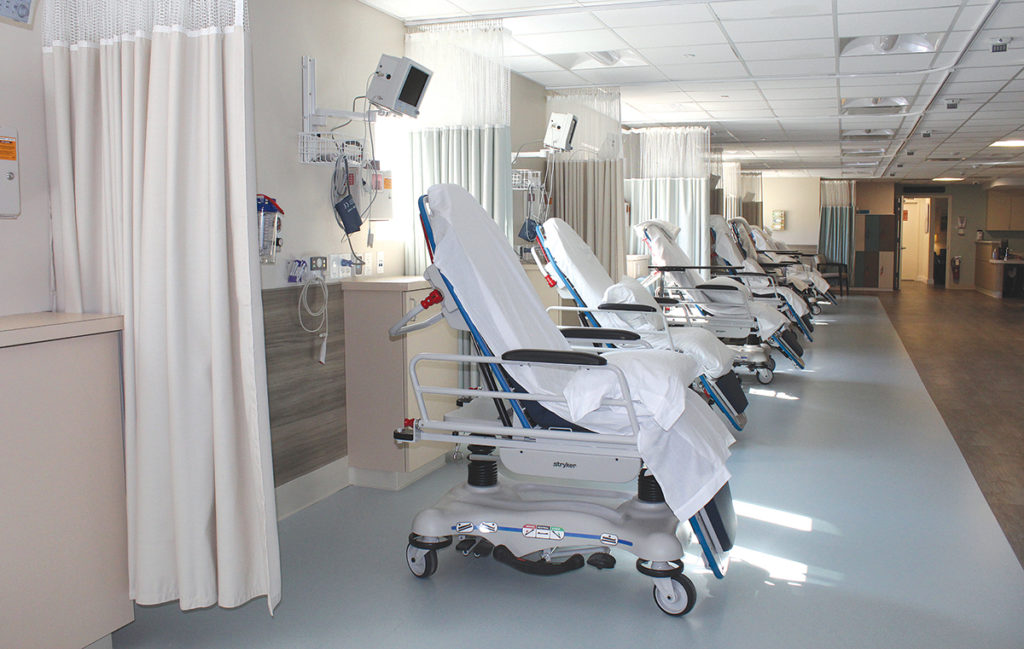Doctors team up to open North Fork Surgical Center in Southold

In a day when medical care is consolidating and smaller practices are being eaten up by larger groups, two doctors from Stony Brook Eastern Long Island Hospital are bucking the trend.
Dr. Dhiren Mehta, a gastroenterologist, and Dr. Frank Adipietro, a pain specialist, have opened the North Fork Surgical Center in Southold to offer outpatient procedures in their practice areas.
It has been a four-year effort, culminating in a Valentine’s Day notice that they’d received final approval from the New York State health department to function at offices on Boisseau Avenue.
“It was easier getting a medical degree,” Dr. Adipietro said, noting hurdles the partners had to jump to make their plan a reality.
There were multiple applications that had to be filed, plus numerous hearings and inspections. They needed permits from Southold Town, Suffolk County and New York State.
Asked why they put themselves through such a bureaucratic ordeal, the doctors said that because some insurance companies are refusing payments for some procedures performed within hospitals or cutting back on reimbursements and hitting patients with high co-pays, they were largely forced to start the independent practice.
“We want to provide top-level care at an equitable price” to people on the East End, Dr. Mehta said.
They can offer that level of medicine with co-pays that will be less than half of what patients have been assessed by their insurance companies, Dr. Adipietro said.
Both practitioners accept a wide range of insurance, including Medicaid, so no patient has to be refused treatment.
At the same time, in rare cases where complications could be expected or a patient prefers treatment in a hospital setting, they can still perform procedures at the Greenport hospital, they said.
The idea started with Dr. Mehta, who brought his proposal to Dr. Adipietro. The pain specialist had been approached by other doctors with similar concepts, but none were as well thought out as Dr. Mehta’s, he said. Initially, they had planned to use a consulting group to guide them in developing the surgical center, but ultimately managed the process themselves.
It started with identifying a site that they now see as perfect, but originally was a vacant, aging building just north of the Long Island Rail Road tracks. On the first walk-through they realized it was an old structure. “This was a lot of work,” Dr. Adipietro said as he showed off the sparkling new facility, which offers amenities few developers might have even proposed.
At the entryway, for example, are vents that provide warm air, but their installation ensures that the heat doesn’t overwhelm the waiting room since the entire building is climate controlled.
For that and many other features, Dr. Adipietro credits Patricia McGrath at Coastal Home, who was involved in every aspect of creating a working space that feels more like a home than a hospital.
“I wanted patients to feel they are in someone’s living room, not a hospital,” Dr. Adipietro said.

A quiet waiting room offers calming music, but no television — and that, too, is purposeful. In the world of news today, Dr. Mehta said, he didn’t want patients waiting for procedures to be disturbed by, or even arguing about, what they might see on TV.
The reception desk has two levels, the lower one positioned to accommodate a person who might enter in a wheelchair. There’s also a private space to interview patients.
The obvious need for a generator to provide back-up power in stormy weather when electrical connections could be lost was no easy step and just one of many construction delays.
The generator couldn’t be rolled in to where it had to be located, but had to be hydraulically lifted over the building.
When patients arrive for a procedure, they are shown to a private room where they can change and given a locker with a key for their belongings. The patient keeps the key throughout the procedure.
The pre-and post-op areas are large and bright and each patient’s vital signs are monitored. Each area has features including chairs that convert to stretchers for many of the procedures — such as the colonoscopies and endoscopies Dr. Mehta performs— to avoid having to move patients from beds to stretchers to operating tables. But there’s also one stretcher specially designed for patients with other problems who may require X-rays. The design enables the patient to be X-rayed through the stretcher.
For procedures where anesthesiology is needed, a qualified physician will be available. All equipment is the state-of-the-art, the doctors said.
“If I’m doing it, let’s do it right,” Dr. Mehta said. That not only includes a top-level endoscope and other machinery and instruments, but sterilizing equipment to protect against infections.
As for his operating room, Dr. Adipietro describes it as “set up perfectly.”
The two doctors expect to begin performing procedures at the surgical center by mid-March. In the meantime, as they complete a few odds and ends, they are seeing patients for intake appointments and scheduling procedures that can wait until they are fully operational.








